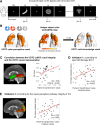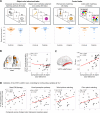Object knowledge representation in the human visual cortex requires a connection with the language system
- PMID: 40392802
- PMCID: PMC12091770
- DOI: 10.1371/journal.pbio.3003161
Object knowledge representation in the human visual cortex requires a connection with the language system
Abstract
How world knowledge is stored in the human brain is a central question in cognitive neuroscience. Object knowledge effects have been commonly observed in higher-order sensory association cortices, with the role of language being highly debated. Using object color as a test case, we investigated whether communication with the language system plays a necessary role in knowledge neural representation in the visual cortex and corresponding behaviors, combining diffusion imaging (measuring white-matter structural integrity), functional MRI (fMRI; measuring functional neural representation of knowledge), and neuropsychological assessments (measuring behavioral integrity) in a group of patients who suffered from stroke (N = 33; 18 with left-hemisphere lesions, 11 with right-hemisphere lesions, and 4 with bilateral lesions). The structural integrity loss of the white-matter connection between the anterior temporal language region and the ventral visual cortex had a significant effect on the neural representation strength of object color knowledge in the ventral visual cortex and on object color knowledge behavior across modalities. These contributions could not be explained by the potential effects of the early visual perception pathway or potential confounding brain or cognitive variables. Our experiments reveal the contribution of the vision-language connection in the ventral occipitotemporal cortex (VOTC) object knowledge neural representation and object knowledge behaviors, highlighting the significance of the language-sensory system interface.
Copyright: © 2025 Liu et al. This is an open access article distributed under the terms of the Creative Commons Attribution License, which permits unrestricted use, distribution, and reproduction in any medium, provided the original author and source are credited.
Conflict of interest statement
The authors have declared that no competing interests exist.
Figures




References
MeSH terms
LinkOut - more resources
Full Text Sources

